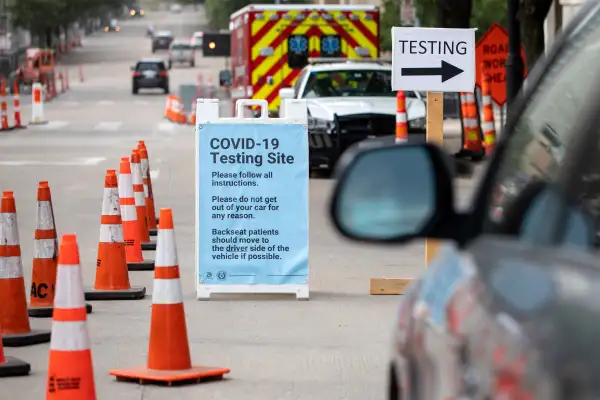Here Are All the States with Coronavirus Travel Restrictions

As coronavirus lockdowns end and vacation season begins, America is on the move again. But not every destination is yet receiving cabin-crazy tourists with open arms — or even elbow bumps. Some states are restricting entry to travelers or imposing requirements on them. And many of the places with rules are popular for summer rest and relaxation.
That said, the vast majority of states — all but nine, by our reporting — are now open to tourists without restrictions. In the other states, you can typically expect a 14-day quarantine, which is sometimes waived if you produce a negative COVID-19 test taken within a certain time (usually 72 hours) before arrival.
In restricted states, the rules may apply to visitors from anywhere or only from states that are current hotspots for the pandemic. At the moment, then, you’re most likely to run into regulations when traveling from Florida or Texas, where infections are rising, and much less so if you’re from New York, New Jersey, or another state where the virus is stable or declining.
The nine states listed below currently have rules on entering their state. As you see, these generally comprise quarantine orders for visitors, sometimes enforced with a threat of fines or imprisonment (which we detail, if the state specifies them). Essential workers are exempt from the restrictions, as a rule. And we haven’t included some states, such as New Jersey, that merely “advise” or “recommend” quarantine for visitors.
If a state isn’t listed here, it wasn’t imposing restrictions as of early July. However, like much else about the pandemic, these rules change quickly; in fact, a few states we note even update them weekly, based on the infection rates in nearby states or counties. It’s wise, then, to check the website for the state you are visiting, especially if you live in a place where COVID-19 infections are rising.
We’ve linked from the names of the states below to the relevant government COVID-19 travel information page. A handy way to check other states is to find your destination in the state-by-state listings on travel site Kayak and click on the Read More link beneath its entry there. These government pages often also provide information on the state of re-opening within the state, including the current requirements for dining and other tourism activities.
Alaska
Anyone entering Alaska from out of state must be tested for COVID-19 between 72 hours and 5 days before arrival in the state, or to be tested upon arrival, and then quarantine at their own expense until they get results. If the visitor’s test is positive, they must isolate for the duration of their illness. Travelers who decline testing must quarantine for 14 days upon arrival.
Connecticut
A mandatory 14-day quarantine is in place for travelers to Connecticut from high-risk states, which include Alabama, Arizona, Arkansas, Delaware, Florida, Kansas, North Carolina, Oklahoma, South Carolina, Utah, and Texas.
Florida
An order requiring travelers flying to Florida from New York, New Jersey, or Connecticut to self-isolate or quarantine for 14 days upon arrival remains in effect, despite Florida’s infection rate now being higher than the ones in those states. The penalty for violations is up to 60 days in prison, a fine of up to $500, or both.
Hawaii
All travelers arriving at Hawaii's airports must self-quarantine within the state for 14 days. Starting August 1, travelers who test negative for COVID-19 72 hours before arrival do not have to self-quarantine. All arriving passengers are required to initial and sign an order confirming they are aware of the 14-day quarantine and acknowledging they understand violating the order is a criminal offense, and subject to up to a $5,000 fine and/or a year imprisonment.
Maine
Visitors to Maine must either quarantine for 14 days or show a recent negative test result; residents of New Hampshire, Vermont, Connecticut, New York, and New Jersey are exempt from the requirements. Violations are subject to a penalty of up to six months in jail and a $1,000 fine.
Massachusetts
All travelers to Massachusetts are “expected to comply” with an order to self-quarantine for 14 days. Travelers from Rhode Island, Connecticut, Vermont, New Hampshire, Maine, New York, and New Jersey are exempt.
New York
A mandatory 14-day quarantine is in place for travelers coming to New York from high-risk states, a list that includes Alabama, Arizona, Arkansas, Delaware, Florida, Kansas, North Carolina, Oklahoma, South Carolina, Utah, and Texas.
The NYS Department of Health says it expects compliance but it “reserves the right to issue a mandatory quarantine order, if needed,” with penalties of up to $10,000 or imprisonment up to 15 days.
Rhode Island
Travelers to Rhode Island from a state with “a positivity rate of COVID-19 greater than 5%” will either have to self-quarantine for 14 days while in Rhode Island, or produce proof of a negative test for COVID-19 that was taken within 72 hours prior to arrival. The state’s list of restricted states is maintained weekly and, at press time, names more than 25 jurisdictions, including Florida, Texas, and California but not including some larger eastern states such as New York and New Jersey.
Vermont
Vermont allows visitors who are driving to the state from counties with fewer than 400 cases per 1 million residents to enter without restrictions. The state updates the infection rates on a map of counties within driving distance every week. Visitors otherwise need to complete a seven- or 14-day quarantine within their home state as well as bringing a negative COVID-19 test with them in order to enter the state.
More from Money:
Traveling During a Pandemic Is Risky. Here's How to Plan a (Mostly) Refundable Trip
The New Rules for Travel Insurance During the Summer of Coronavirus
